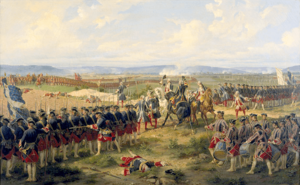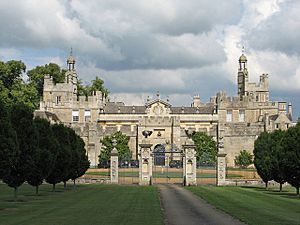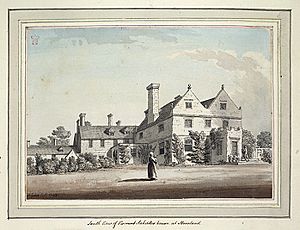George Germain, 1st Viscount Sackville facts for kids
Quick facts for kids
The Viscount Sackville
|
|
|---|---|
 |
|
| Secretary of State for the Colonies | |
| In office 10 November 1775 – February 1782 |
|
| Monarch | George III |
| Prime Minister | Lord North |
| Preceded by | The Earl of Dartmouth |
| Succeeded by | Welbore Ellis |
| First Lord of Trade | |
| In office 10 November 1775 – 6 November 1779 |
|
| Monarch | George III |
| Prime Minister | Lord North |
| Preceded by | The Earl of Dartmouth |
| Succeeded by | The Earl of Carlisle |
| Personal details | |
| Born |
George Sackville
26 January 1716 |
| Died | 26 August 1785 (aged 69) Stoneland Lodge, Sussex |
| Nationality | British |
| Political party | Tory (Northite) |
| Spouse | Diana Sambrooke (d. 1778) |
| Alma mater | Trinity College, Dublin |
George Germain, 1st Viscount Sackville (born January 26, 1716 – died August 26, 1785), was a British soldier and politician. He was known by different names during his life: The Honourable George Sackville, Lord George Sackville, and Lord George Germain.
He served as the Secretary of State for America during the American War of Independence. This was under the government of Lord North. Many people blamed him for Britain losing its thirteen American colonies. This was partly because he gave very detailed military orders. He also didn't fully understand the geography of the colonies or how determined the colonists were.
George Germain had two main careers. His military career was successful at first, but it ended with a court martial. He fought in the War of the Austrian Succession and the Seven Years' War. This included the important Battle of Minden. His political career ended when Lord North's government fell in March 1782.
Contents
Early Life and Education
George Sackville was born on January 26, 1716. He was the third son of Lionel Sackville, 1st Duke of Dorset. His godfather was King George I.
He went to Westminster School in London. Later, he studied at Trinity College in Dublin, graduating in 1737. His father was the Lord Lieutenant of Ireland (a high-ranking official) from 1730 to 1737 and again from 1750 to 1755. While in Dublin, George became friends with the famous writer Jonathan Swift. He also met Lord Ligonier, who later helped him in his army career.
After college, George Sackville joined the army. He also became the Grandmaster of the Grand Lodge of Ireland in 1751, a position he held for two years.
Family Life
George Sackville married Diana Sambrooke on September 3, 1754. They had five children together.
Their children included:
- Diana Sackville (1756–1814)
- Charles Sackville (1767–1843), who later changed his name to Charles Sackville-Germain.
- George Sackville (1770–1836)
- Elizabeth, who married Henry Herbert.
Military Career Beginnings
George Sackville started his army career as a captain. He was in the 7th Horse regiment. In 1740, he moved to the Gloucestershire Regiment of Foot as a lieutenant colonel. This regiment was sent to Germany to fight in the War of the Austrian Succession. In 1743, he was promoted to colonel.
Battle of Fontenoy

George Sackville fought in his first major battle at Battle of Fontenoy in 1745. He led his infantry regiment deep into the French lines. He was wounded and captured, even being taken to the tent of King Louis XV. After being released, he returned to duty in Scotland. He became the Colonel of the 20th Foot Regiment.
From 1747 to 1748, he served again with the Duke of Cumberland in Holland. There was a break in his military service between 1750 and 1755. During this time, he worked as the first secretary to his father.
George Sackville returned to active military service during the Seven Years' War. He was considered for the top army job in North America. In 1755, he was promoted to major general. In 1758, he became a lieutenant general and joined the Duke of Marlborough in Germany. He also became a member of the Privy Council in January 1758.
Raid on St Malo
In June 1758, George Sackville was second-in-command of a British mission. This mission, led by the Duke of Marlborough, tried to attack St Malo by sea. The raid didn't capture the town, but it was still seen as a success because it distracted the French. Later that year, Sackville joined the allied forces in Germany. He became the commander of the British soldiers there after Marlborough died.
The Battle of Minden and Its Aftermath
Battle of Minden
The Battle of Minden took place on August 1, 1759. British and Hanoverian soldiers attacked the French cavalry and artillery. They charged forward without direct orders and bravely fought off French attacks. As the French began to retreat, the allied commander, Duke Ferdinand, ordered a British cavalry charge to finish the battle.
However, George Sackville, who was in charge of the British cavalry, held back. He refused to let them advance. Duke Ferdinand sent the order several times, but Sackville still wouldn't let the cavalry attack. This was partly because he didn't get along with Lord Granby, another commander. Because of this, Sackville was removed from his command and sent back to Britain. Lord Granby took his place.
Court Martial
George Sackville refused to accept blame for not obeying orders at Minden. Back in England, he demanded a court martial (a military trial) to clear his name. The trial took place in 1760.
The court found him guilty. They gave him a very harsh punishment. He was not only removed from the army, but the court also ruled that he was "unfit to serve His Majesty in any military Capacity whatever." This verdict was ordered to be read to every regiment in the army. The king also removed his name from the Privy Council list.
Return to Politics

George Sackville had been a Member of Parliament (MP) at different times since 1733. He had served in both the Irish and British parliaments.
From 1750 to 1755, he was the Chief Secretary for Ireland. This was during his father's second time as Lord Lieutenant of Ireland.
When King George III became king in 1760, George Sackville slowly started to get back into politics. People began to forget the problems of the Seven Years' War. The king quietly put him back on the Privy Council list in 1765.
At first, he supported George Grenville's political group. But he soon became a strong supporter of Lord North. In 1769, he made this alliance official. That same year, Lady Elizabeth Germain died and left her properties, including Drayton House, to him. This made him much wealthier and allowed him to formally change his name. After 1770, he was known as Lord George Germain.
Secretary of State for America
Appointment to Office
On November 10, 1775, Lord George Germain was appointed Secretary of State for the American Department. He took over from Lord Dartmouth. At this time, the government had three Secretaries of State. One handled Europe, one handled America, and one handled the rest of the world.
These secretaries were in charge of colonial administration and military actions in their areas. This meant Germain became the main minister responsible for stopping the rebellion that had started in the American colonies in 1775. He was involved in choosing generals, managing supplies, and planning the war strategy.
The American War of Independence
Lord George Germain and Lord North made three big mistakes about the war. First, they thought American forces couldn't stand up to the British army. Second, they believed the war would be like wars they had won in Europe. Third, they thought winning would make the colonies loyal again. All these ideas turned out to be wrong. While American forces often struggled in open battles, they used different, more successful tactics.
In 1776, Germain worked with General Burgoyne to plan the Saratoga campaign. However, his unclear orders to General Howe helped cause the campaign to fail. When France, Spain, and the Dutch Republic joined the war, Britain focused more on a global war. British troops were moved from Philadelphia to protect valuable sugar-producing islands in the West Indies.
Yorktown and Its Impact
In 1781, confusing orders sent to Cornwallis from Clinton contributed to the British loss at Yorktown.
News of the defeat at Yorktown reached London on November 25, 1781. The messenger went straight to Germain's home. Germain then told the other ministers, and they went to Lord North. North reportedly cried, "Oh God - It's all over." It was decided that Germain should tell the king the bad news. The king's speech had to be rewritten because of Yorktown.
The news of the surrender made the political opposition stronger. Government support began to drop. Germain still wanted to continue the war. He suggested using British bases in Charleston, New York, Savannah, and Canada to attack the American coast. He also wanted to re-occupy Newport in Rhode Island.
Leaving Office
Germain became a target for the opposition. He was eventually convinced to step down from his job. In February 1782, he was given a special title: Baron Bolebrooke and Viscount Sackville. This was seen as necessary for Lord North's government to survive. He was replaced by Welbore Ellis.
Even with Germain's departure, Lord North's government fell shortly after in February 1782. This led to a period of political instability. Soon after, news arrived of a big British naval victory in the Caribbean, the Battle of the Saintes. This would have helped the government if it had still been in power. The new government eventually agreed to the Peace of Paris in 1783, which officially ended the war and recognized the United States as an independent country.
Later Life and Legacy
The debate over Lord Sackville's actions during the war continued. Some people didn't want him to join the House of Lords, which was very unusual. However, he was allowed to join. His health declined, and the issue soon became less important. He retired to his country home at Stoneland Lodge.
George Germain died there in 1785. Until his last day, he insisted he had not been a coward at Minden. After his death, a book defending his reputation was written by Richard Cumberland.
His estate, Drayton House, went to his son Charles. Charles later became the 5th (and last) Duke of Dorset. The Stoneland estate passed to his daughter, Countess de la Warr.
Legacy
- Fort Sackville (Nova Scotia), Canada, is named after him.
- Lower Sackville, Nova Scotia and Upper Sackville, Nova Scotia are also named after him.
- Germain Street in Saint John, New Brunswick is named in his honor.
- Sackville, New South Wales in Australia.
- The Town of Sackville, New Brunswick was formally created in 1765 and named for Viscount Sackville. It became part of the Province of New Brunswick in 1784 and was incorporated as a town in 1903.
See also
 In Spanish: George Germain para niños
In Spanish: George Germain para niños



